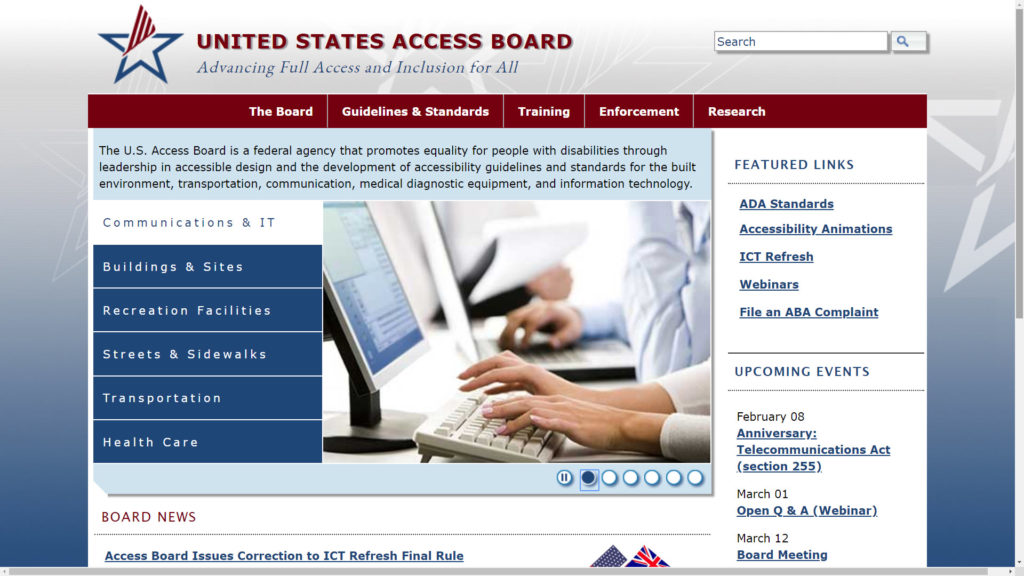Summary

The Section 508 requirements were established in 1998, and they require Federal agencies to develop and procure technology accessible to people with disabilities. Over the past 20 years, many technological changes have taken place, and these changes have necessitated updates to the Section 508 requirements. After a great deal of consideration and development by the US Access Board, the Section 508 refresh went into effect on January 18th, 2018.
Here are five essential facts about the refresh:
- All products must now conform to the Web Content Accessibility Guidelines 2.0 (WCAG) level A and AA standards. Even if your product is not for the web, you are still accountable to WCAG as it is written — substitute the word “web” or “web page” with the appropriate medium, such as “document.” Because the WCAG standards have been added to Section 508, there are now aspects of 508 compliance that did not exist before. These new areas of compliance are:
- Meaningful Sequence
- Sensory Characteristics
- No Keyboard Trap
- Focus Order
- Link Purpose (In Context)
- Language of Page
- On Focus
- Parsing
- Contrast (Minimum)
- Resize Text
- Multiple Ways
- Headings and Labels
- Language of Parts
- Error Suggestion
- Error Prevention (Legal, Financial, Data)
- Eventually, the World Wide Web Consortium will update WCAG 2.0 to 2.1, and so on. However, Section 508 will not be affected by those updates. For now, only WCAG 2.0 standards are applicable to Section 508.
- As part of the refresh, Section 508 now has a “Safe Harbor Provision.” It means that if you complied with the old requirements, and if your product has not been modified at all, then you are not required to meet the revised requirements. However, if you make any changes to your product that affect your users, then you must meet the new requirements.
- To help you identify and document accessibility requirements, the General Services Administration has built a tool called ART (Accessibility Requirements Tool), which can help you determine if Section 508 applies to a product. They have also provided a Revised 508 Standards Toolkit to help people learn more about where to begin with accessibility remediation.
- As before, the Volutary Product Accessibility Template (VPAT) document lets companies publicly share their level of compliance with Section 508. As part of the 508 refresh, a “VPAT 2.0” has been developed. Here are a few noteworthy changes to the template:
- Similar to WCAG Conformance statements, the VPAT 2.0 template requires you to list the evaluation methods used during your accessibility testing. For example, if Equal Entry tested a web application for a client, then the Evaluation Methods may include JAWS, keyboard-only, large text, magnifier, and Colour Contrast Analyzer. We recommend performing manual evaluations with multiple tools to ensure compliance.
- You can provide legal disclaimer text if your organization requires it. Most companies have their own unique disclaimer text, and yours may differ from the legal disclaimers used by other companies in your field.
- In the Detail Tables, you now have the option to list specific areas of accessibility as “Not Evaluated.” This may be useful for the higher-level WCAG level AAA requirements, such as sign language interpretation for all your video content.
Do you have questions or concerns about your product’s current level of Section 508 compliance? Contact Equal Entry for a consultation.
#2 is not really correct; WCAG 2.0 will always be WCAG 2.0.
PS: Please underline the text links.
Thank you for the feedback, we have addressed the underlining of text links. What do you think?
Your comment on WCAG 2.0 is noted, we don’t think either of us is disagreeing on that point.
Was the 508 refresh change not January 18, 2017, instead of 2018?
Hi Carolyn,
Great question! On January 18, 2017, the Access Board published a final rule that jointly updates requirements for information and communication technology covered by Section 508 of the Rehabilitation Act and Section 255 of the Communication Act. However, Federal agencies were not expected to comply with the Revised 508 Standards until January 18, 2018 (see Revised 508 Standards Roadmap).